The Economics and Statistics Division maintains archives of previous publications for accountability purposes, but makes no updates to keep these documents current with the latest data revisions from Statistics Canada. As a result, information in older documents may not be accurate. Please exercise caution when referring to older documents. For the latest information and historical data, please contact the individual listed to the right.
<--- Return to Archive
For additional information relating to this article, please contact:
July 26, 2022INFRASTRUCTURE: WATER AND WASTEWATER, 2020 Statistics Canada has released new infrastructure data on publicly owned water and wastewater assets for 2020.


In 2020, Nova Scotia reported 270 structures for water treatment, including 69 treatment facilities, 38 reservoirs before intake (including dams), 84 storage tanks (after intake) and 79 pump stations. Statistics Canada's reported conditions of these assets shows that:
- 71.3% of water treatment facilities were in fair, good or very good condition
- 83.0% of reservoirs were in fair, good or very good condition
- 84.3% of storage tanks were in fair, good or very good condition
- 88.3% of pump stations were in fair, good or very good condition
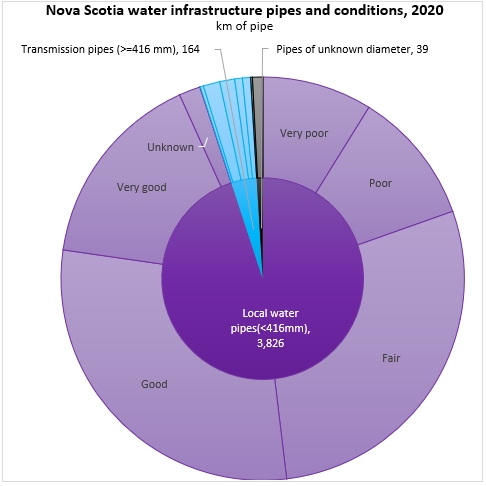
In addition to facilities, Nova Scotia also has 4,029 km of water distribution pipes, the vast majority of which were local water pipes with diameter less than 416 mm. Of these local water pipes, 77.5% were in fair, good or very good condition.
Compared with the national average of facilities per 1,000,000 residents, Nova Scotia has fewer than average water treatment facilities, reservoirs and pump stations, but higher than average storage tanks.

In 2020, Nova Scotia reported fewer km per million residents of all types of piped water infrastructure.

Nova Scotia also reported 1,118 wastewater structures, including 98 wastewater treatment plants, 50 lagoon systems, 405 wastewater pump stations, 377 wastewater lift stations and 188 wastewater storage tanks. In condition ratings for Nova Scotia's wastewater infrastructure in 2020:
- 78.2% of wastewater treatment plants were in fair, good or very good condition
- 87.0% of lagoon systems were in fair, good or very good condition
- 60.7% of wastewater pump stations were in fair, good or very good condition
- 85.3% of wastewater lift stations were in fair, good or very good condition
- 96.2% of wastewater storage takes were in fair, good or very good condition
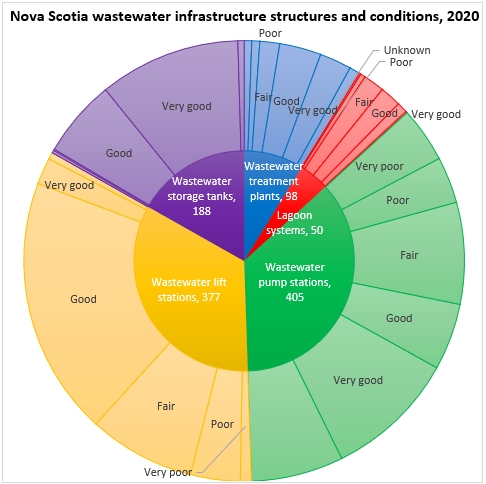
In 2020, Nova Scotia reported 4,769 km of sewer pipe infrastructure, of which almost two thirds was sewer pipes of less than 450mm in diameter and a further 17% was sewer pipe of unknown diameter. Of sewer pipes with less than 450mm in diameter, 73.6% were in fair, good or very good condition. Of sewer pipes of unknown diameter, 60.4% were in fair, good and very good condition (and 39.4% were in poor condition).
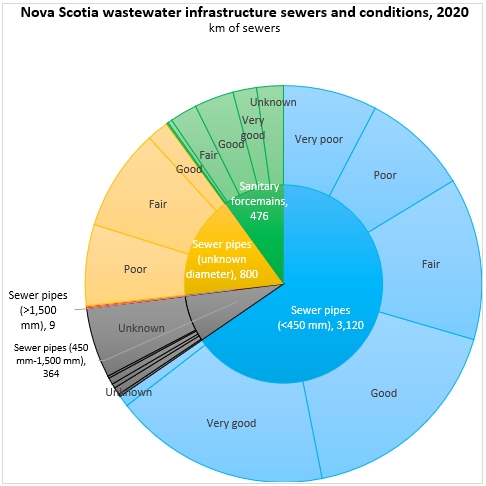
Compared against national averages per 1 million residents, Nova Scotia had more wastewater treatment facilities, pump stations, lift stations and storage tanks, but fewer lagoon systems.
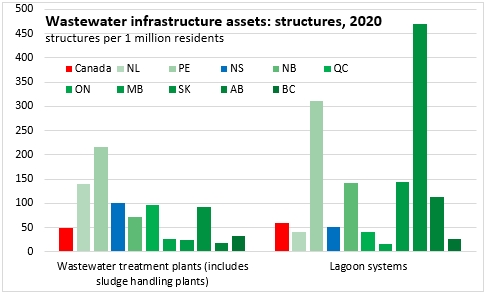

Nova Scotia reported less than the national average km/million residents of sewer pipes with diameters under 450mm as well as sewers with diameters between 450 and 1,500mm as well as sewers with diameters in excess of 1,500mm. Nova Scotia reported more than average km per million residents in sewer pipes of unknown diameter as well as sanitary forcemains.
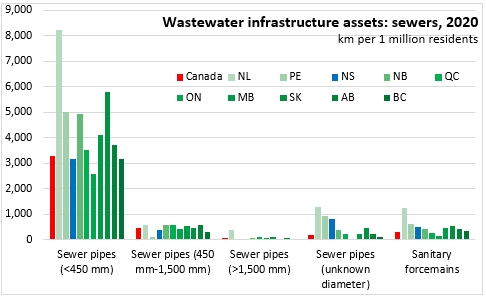
Definitions for asset conditions from Statistics Canada's Core Public Infrastructure Survey
-
Very poor: Immediate need to replace most or all of the asset. Health and safety hazards exist which present a possible risk to public safety or asset cannot be serviced/operated without risk to personnel. Major work or replacement required urgently.
-
Poor: Failure likely and substantial work required in the short term. Asset barely serviceable. No immediate risk to health or safety.
-
Fair: Significant deterioration is evident; minor components or isolated sections of the asset need replacement or repair now, but asset is still serviceable and functions safely at adequate level of service.
-
Good: Acceptable physical condition; minimal short-term failure risk but potential for deterioration in the long term. Only minor work required.
-
Very good: Sound physical condition. No short-term failure risk and no work required.
Sources: Statistics Canada. Table 34-10-0192-01 Inventory of publicly owned potable water assets, Infrastructure Canada; Table 34-10-0196-01 Inventory distribution of publicly owned potable water assets by physical condition rating, Infrastructure Canada; Table 34-10-0222-01 Inventory of publicly owned wastewater assets, Infrastructure Canada; Table 34-10-0226-01 Inventory distribution of publicly owned wastewater assets by physical condition rating, Infrastructure Canada
<--- Return to Archive